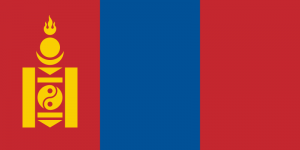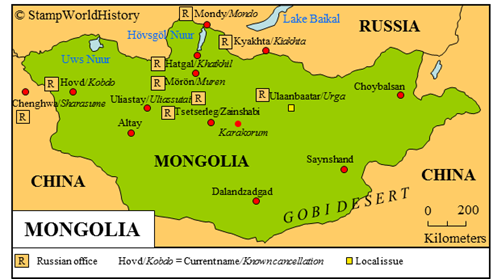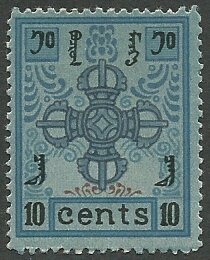Монгол улс

Mongolia
Quick reference
General issues: Khanate 1924, Peoples republic 1924-1992, Republic 1992-Present
Country name on general issues: Mongolia in Mongolian script, Mongolia, МОНОЛ ШУУДАН, БМАУ ШУУДАН, МОНГОЛ УЛС, МОНГОЛ УЛСЬІН, ШУУДАН
Special issues: Local issue Ulaanbaatar 1931
Currency: 1 Dollar = 100 Cent 1924-1926, 1 Tukrit = 100 Mongo 1926-Present
Population: 681 000 in 1924, 2 839 000 in 2013
Political history Mongolia
Mongolia is located in eastern Asia. Once Mongolia was one of the largest empires of the world, ruled from Karakorum by Genghis Khan and stretching from China to Europe. In the 19th century, Mongolia is part of China. When, in 1911, the Chinese Empire collapses, Mongolia proclaims its independence. Mongolia is supported by Russia, but the Chinese refuse to relinquish their claims on Mongolia. In 1915, China and Russia agree upon self government for Mongolia. When Russia is submerged in the civil war that follows the Russian revolution in 1917, China, in 1919, invades Mongolia to enforce more direct Chinese rule. Eventually, Mongolian and Russian forces manage to oust the Chinese from Mongolia. De facto independence is thus established. Mongolia is proclaimed a khanate. The khan only has nominal power though, the real power being in the hands of the Mongolian communist party oriented to Russia. Upon the death of the khan in 1924, the peoples republic of Mongolia is proclaimed.
Chinese recognition of Mongolian independence is gained in 1945 under Russian pressure. Because of the large Soviet Russian influence in Mongolia, it is long considered a Soviet puppet state. International recognition is slow to come. Mongolia is admitted to the United Nations in 1961. The breakup of the Soviet Union in the early 1990’s has its influence also in Mongolia. The country goes through a process of liberalization and, in 1992, Mongolia becomes a republic with a multi party system.
Postal history Mongolia
The first postal services in Mongolia are established by the Russians. In 1863, a Russian post office is opened in Urga, the current Ulaanbaatar. The Russians have post offices in several other cities. Russian stamps would be used, cities being recognizable by the cancellation that would read Mongolia and the name of the city as it was then known to the Russians. Such cancellations are also known to be used outside the borders of current Mongolia: in Sharasume, currently Chenghwan in China, and in the border towns of Kiakhta and Mondo in Russia, currently known as Khyathka and Mondy. A Chinese office existed in Urga from 1909 until 1912 and again from 1919 until 1921.
The Mongolians took over the postal services in the country in 1924, expanding the network the Russians had built up. The first stamps are issued in 1924 in the name of the khanate of Mongolia showing the Vajra, a scepter that is a religious symbol in Buddhism, the predominant religion in Mongolia. These issues are superseded by the issues of the peoples republic of Mongolia. Since then Mongolia has issued stamps which either serve as national propaganda or are aimed at the thematic collectors market. Stamps issued in 1931 with an overprint in English and Mongolian are listed in Michel as local issues for Ulaanbaatar. Since the stamps of the peoples republic of Mongolia are superseded by those of the republic of Mongolia, the cultural heritage of Mongolia has become a more dominant subject on the stamps issued.
Album pages
← Previous page: ManchukuoNext page: Mountain Republic →




The caption for the Mongolian stamp of 1924 should be “Vajra” instead of “Varja”
William
Thanks. It is amazing to see that apparently no amount of proofreading is enough to get rid of all typos…..
Gerben
I was a professional proofreader for 12 years so it is just part of my nature now to look for these things. Considering the complexity of the profiles, they really are in excellent shape.
William
William
I sure hope StampWorldHistory may benefit from your professional skills some more!